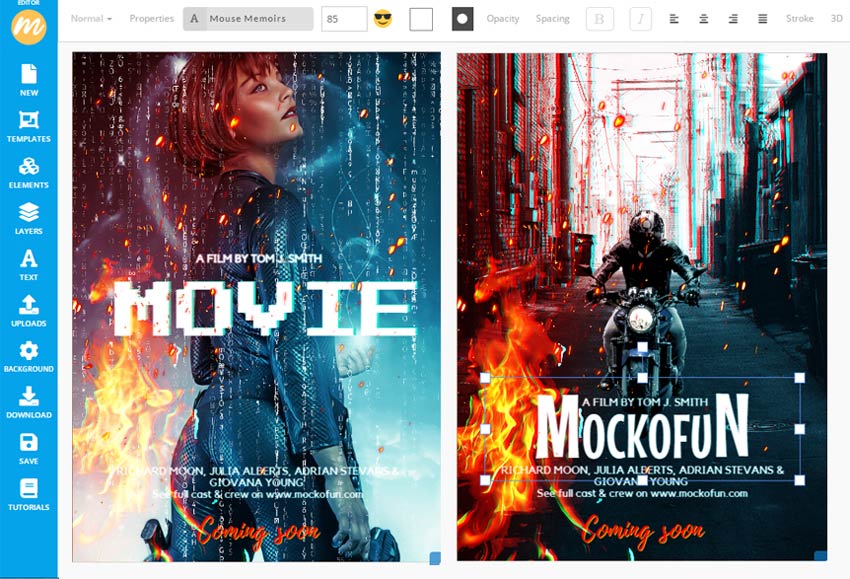Lights, Camera, AI: Revolutionizing Movie Posters with Intelligent Design
Lights, Camera, AI: Revolutionizing Movie Posters with Intelligent Design
Blog Article

In the rapidly evolving landscape of the film industry, the fusion of technology and creativity is reshaping how movies are marketed. One of the most exciting advancements in this domain is the emergence of AI movie poster generators. These innovative tools harness the power of artificial intelligence to create stunning visual representations that capture the essence of films, often with striking speed and efficiency. As filmmakers and marketers strive to capture audiences' attention in a crowded marketplace, AI-driven design offers a fresh approach to crafting eye-catching promotions.
Gone are the days where tedious design processes consumed countless hours and resources. With AI movie poster generators, filmmakers can now produce unique and engaging posters tailored to their film’s narrative and aesthetic in a fraction of the time. This technology not only streamlines the creative process but also allows for greater experimentation and diversity in design. By leveraging machine learning algorithms, these tools analyze existing designs and trends, empowering users to create visually compelling posters that resonate with target audiences. As we delve deeper into this captivating intersection of film and technology, we explore how AI is revolutionizing the way movie posters are conceived and produced.
The Rise of AI in Graphic Design
In recent years, artificial intelligence has made significant inroads into various domains, and graphic design is no exception. The introduction of AI technology has transformed how designers approach their work, enabling them to explore new creative avenues and streamline their processes. As AI continues to evolve, it is becoming an indispensable tool for both professional designers and amateurs alike. This shift is particularly evident in the realm of movie poster design, where capturing the essence of a film in a single image is crucial for attracting audiences.
AI movie poster generators have emerged as a game-changer in the graphic design landscape. These platforms utilize advanced algorithms to analyze existing designs, styles, and trends, allowing users to create visually compelling posters with minimal effort. With just a few input parameters, such as genre, theme, and color palette, these generators produce unique designs that can resonate with viewers and reflect the film's narrative. This innovative approach not only saves time for designers but also democratizes the creative process, making it accessible to individuals without formal design training.
Moreover, the ability of AI to learn and adapt over time enhances its effectiveness in graphic design. As more users engage with AI movie poster generators, the systems become better at understanding what works and what doesn't. They can generate designs that align with audience preferences, ensuring that movie posters are not only aesthetically pleasing but also marketable. This evolution of design capabilities marks a significant milestone in the intersection of technology and creativity, paving the way for a new era in visual storytelling.
How AI Movie Poster Generators Work
AI movie poster generators utilize advanced algorithms and machine learning techniques to create visually appealing and thematic designs. These tools are trained on vast datasets of existing movie posters, learning the elements that make certain designs successful. Through this training, they can analyze color schemes, typography, imagery, and layout styles that resonate with audiences. This understanding allows the AI to generate posters that not only capture the essence of the film but also appeal to target demographics.
Once a user inputs specific details about their film, such as genre, mood, and key elements, the AI processes this information to produce customized designs. It combines various design elements from its learned database while also offering a degree of creative originality. Users can manipulate aspects like colors and fonts through intuitive interfaces, allowing for personalized adjustments while still benefiting from the AI's design expertise.
After generating several poster options, the system often integrates feedback mechanisms that help refine the outputs. This could involve ranking the generated designs based on user preferences or incorporating real-time data to identify trending styles. By continuously learning from user interactions and design trends, AI movie poster generators are evolving to create even more compelling and impactful visuals, thus revolutionizing the poster design process.
Impact on the Film Industry
The introduction of AI movie poster generators is reshaping how film marketing is approached in the industry. These tools allow filmmakers and marketing teams to generate visually stunning movie posters in a fraction of the time it would typically take. By leveraging algorithms that analyze design trends and audience preferences, these generators can create tailored posters that resonate with target demographics, thus enhancing audience engagement from the start.
Additionally, the cost efficiency of AI-generated posters cannot be understated. Traditional methods of creating promotional material often involve hiring skilled graphic designers, which can be both time-consuming and expensive. With AI technology, studios can produce high-quality posters without incurring significant costs, freeing up resources for other aspects of film production and marketing. This democratization of design allows even independent filmmakers to access professional-grade promotional materials, leveling the playing field in the film market.
Free movie poster template creator
Furthermore, AI movie poster generators provide insights through data analysis that inform design choices. By assessing audience reactions and trends in real-time, these tools can be adjusted to optimize the appeal of film posters. This adaptability not only helps in creating more compelling visuals but also allows filmmakers to experiment with different artistic styles, thereby fostering creativity and innovation within the industry. As a result, the film industry is experiencing a transformation that emphasizes both artistic vision and technological advancement.
Report this page